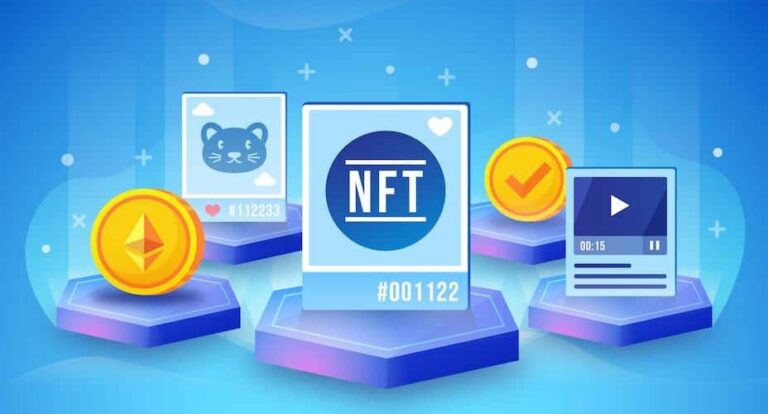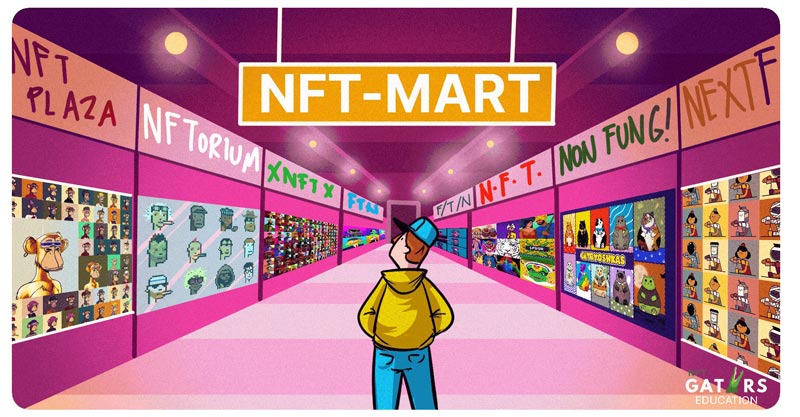Non-fungible tokens (NFTs) are digital assets that are revolutionizing the way we perceive and trade unique digital items. NFTs are being used for everything from collectibles to digital art, and as the popularity of NFTs continues to grow, the demand for NFT marketplaces has increased. If you are considering how to create an NFT marketplace, here’s a guide to help you get started.
Why do people develop NFT marketplaces?
People create NFT marketplaces for a variety of reasons, depending on their goals and interests. Some of the reasons why people create NFT marketplaces include:
To showcase and sell digital art
NFT marketplaces provide a platform for digital artists to showcase their work and sell it to collectors. By creating an NFT marketplace, artists can reach a wider audience and potentially earn more money for their work.
To create a marketplace for collectibles
NFTs can also be used to represent collectibles like trading cards, sports memorabilia, and other unique items. NFT marketplaces provide a platform for collectors to buy and sell these items, and for creators to issue new collectibles.
To support charitable causes
Some NFT marketplaces are created to support charitable causes or social impact projects. NFTs can be used to represent charitable donations, and the proceeds from the sale of these NFTs can be donated to the chosen charity.
To create a new revenue stream
NFT marketplaces provide an opportunity for entrepreneurs to create a new revenue stream by selling NFTs. By creating an NFT marketplace, entrepreneurs can potentially earn money through transaction fees or by taking a commission on NFT sales.
To create a unique user experience
NFT marketplaces can provide a unique user experience that is not available on traditional e-commerce platforms. For example, NFT marketplaces can offer features like bidding and auctions, royalties on secondary sales, and exclusive access to limited-edition NFTs.
People create NFT marketplaces for a variety of reasons, and the potential use cases for NFTs are only limited by the imagination of their creators.
Successful Examples of NFT Marketplaces
There are several NFT marketplaces that have emerged as successful platforms in the fast-growing NFT ecosystem. Here are some of the most successful NFT marketplaces:
OpenSea: OpenSea is the largest NFT marketplace, with over 4 million items sold and a trading volume of over $11 billion as of February 2022. The platform allows users to buy, sell, and discover NFTs across a wide range of categories, including art, gaming, and collectibles.
Nifty Gateway: Nifty Gateway is a curated NFT marketplace that focuses on high-quality, limited edition drops from popular artists and brands. The platform has gained popularity for its exclusive drops and partnerships with celebrities and influencers.
SuperRare: SuperRare is an exclusive NFT marketplace that features limited edition, high-quality digital art from top artists. The platform is known for its curation and vetting process, which ensures that all NFTs on the platform are of the highest quality.
Rarible: Rarible is an open NFT marketplace that allows anyone to mint and sell NFTs. The platform has gained popularity for its user-friendly interface, low fees, and support for a wide range of NFT types, including digital art, music, and videos.
Binance NFT Marketplace: Binance NFT Marketplace is a popular NFT marketplace launched by the leading cryptocurrency exchange Binance. The platform features a wide range of NFTs across different categories, including gaming, sports, and collectibles.
Tech stack for NFT marketplace app development
Creating an NFT marketplace requires a combination of different technologies and tools to ensure a seamless and secure user experience. Here are some of the key technologies and tools that are typically used to create an NFT marketplace:
Blockchain Technology
NFTs are created and managed using blockchain technology, which provides the necessary security and transparency for the transactions. Most NFT marketplaces are built on top of blockchain networks like Ethereum, Binance Smart Chain, or Flow.
Smart Contracts
Smart contracts are self-executing programs that facilitate the buying and selling of NFTs in a secure and automated way. Smart contracts are used to define the terms and conditions of the NFT sale, including the price, royalty fees, and other transaction details.
Cryptocurrency Wallets
Cryptocurrency wallets like MetaMask, Coinbase Wallet, or Trust Wallet are essential for users to store and manage their NFTs and cryptocurrency. NFT marketplaces typically integrate with different wallets to enable users to connect their wallets and make transactions on the marketplace.
IPFS (InterPlanetary File System)
IPFS is a decentralized protocol for storing and sharing files on a distributed network. NFT marketplaces typically use IPFS to store and host the media files associated with the NFTs, such as images, videos, or music files.
Web3 Frameworks
Web3 frameworks like React.js, Angular.js, or Vue.js are commonly used to build the user interface of NFT marketplaces. These frameworks enable the creation of responsive and user-friendly interfaces that interact with blockchain networks and smart contracts.
Cloud Hosting
NFT marketplaces require scalable and reliable hosting solutions to handle the large volume of transactions and user traffic. Cloud hosting services like Amazon Web Services or Google Cloud Platform are commonly used to provide the necessary infrastructure for NFT marketplaces.
These are some of the key technologies and tools that are typically used to create an NFT marketplace. However, the specific technology stack may vary depending on the specific requirements and preferences of the development team.
Key features of NFT marketplace apps
While there may be variations between different NFT marketplaces, some key features that are typically included in an NFT marketplace are:
User-Friendly Interface
A user-friendly interface that makes it easy for users to navigate the marketplace and find the NFTs they are interested in.
Crypto Wallet Integration
Integration with different crypto wallets such as MetaMask and Coinbase Wallet to allow users to connect their wallets and facilitate transactions.
Search and Filtering
Advanced search and filtering capabilities to help users find specific NFTs based on different criteria, such as category, artist, or price.
Smart Contract Integration
Integration of smart contracts to ensure secure and transparent transactions between buyers and sellers.
Auctions and Bids
Ability to host auctions and receive bids on NFTs, allowing for dynamic pricing based on supply and demand.
Social Features
Social features that allow users to follow other users, artists, and collections, and interact with them through comments and likes.
Royalty Payments
Automatic royalty payments to artists when their NFTs are resold on the marketplace, which incentivizes artists to create and sell more NFTs.
Analytics and Insights
Analytics and insights to track performance and gain insights into user behavior and preferences, which can help inform business decisions.
These are some of the key features that are typically included in an NFT marketplace app. However, as the NFT market evolves, new features and functionalities may emerge to meet the changing needs and preferences of users.
Key steps of NFT marketplace app development
Now, that we know something about leading examples, tech stack, and features of NFT marketplace apps, it’s time to learn the key steps of developing your own NFT marketplace.
Step 1: Research
Before you start building your NFT marketplace, you need to research the market thoroughly. Look at the existing NFT marketplaces and analyze their features and functionalities. Find out what works and what doesn’t, and what features are essential for an NFT marketplace. This research will help you understand the market demand and ensure that you build a marketplace that meets the needs of your target audience.
Step 2: Choose a Blockchain
NFTs are created and traded on blockchains, so you need to choose a blockchain that supports NFTs. Ethereum is currently the most popular blockchain for NFTs, but other blockchains like Binance Smart Chain and Polygon are gaining traction. Consider the transaction fees, security, and ease of use when choosing a blockchain.
Step 3: Design and Develop
The design of your NFT marketplace should be user-friendly and intuitive. Consider using a template or hiring a professional designer to create a visually appealing and functional marketplace.
Once you have a design, you’ll need to develop the marketplace. You can use existing platforms like OpenSea or Rarible, or you can develop a custom marketplace. If you choose to build a custom marketplace, you’ll need to hire developers who are experienced in blockchain development.
Step 4: Integrate Wallets
To buy and sell NFTs, users need a crypto wallet. You need to integrate different types of crypto wallets into your marketplace, such as MetaMask and Coinbase Wallet. This integration ensures that users can easily connect their wallets to the marketplace and start trading NFTs.
Step 5: Smart Contract Integration
Smart contracts are the backbone of NFTs. They are self-executing contracts with the terms of the agreement between buyer and seller directly written into lines of code. You need to integrate smart contracts into your NFT marketplace to enable transactions between buyers and sellers.
Step 6: Test and Launch
Before launching your NFT marketplace, you need to test it thoroughly. Test the functionalities, security, and usability of the marketplace to ensure that everything works as intended. Once you’re confident that the marketplace is working correctly, you can launch it to the public.
Creating an NFT marketplace requires a lot of planning and development, but it can be a profitable venture. By following the steps outlined in this article, you can create a functional and user-friendly NFT marketplace that meets the needs of your target audience.
Conclusion
NFT marketplaces can be used for a variety of purposes, including showcasing digital art, selling collectibles, supporting charitable causes, creating a new revenue stream, and offering a unique user experience. The potential use cases for NFTs are vast, and they offer exciting opportunities for creators, collectors, and entrepreneurs.
NFT market is still in its early stages, and there is a lot of room for innovation and growth. As the market continues to mature, we can expect to see new use cases and applications for NFTs, and the potential for disruption in traditional industries. If you are interested in creating an NFT marketplace, it is essential to stay up-to-date with the latest trends and developments in the market, and to be open to experimentation and new ideas.


0 Comments